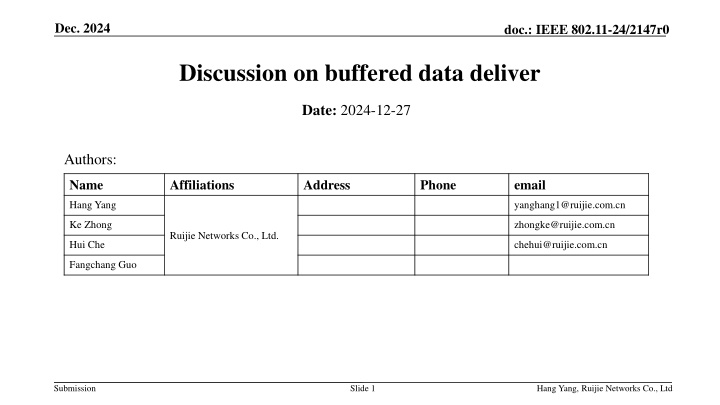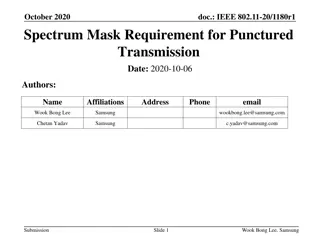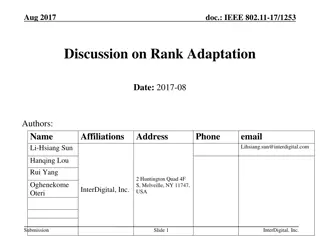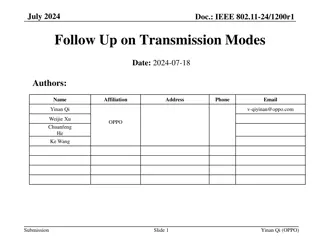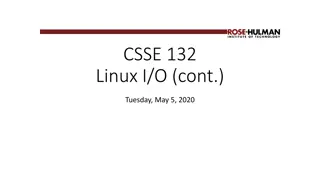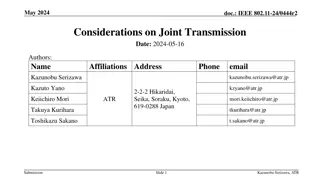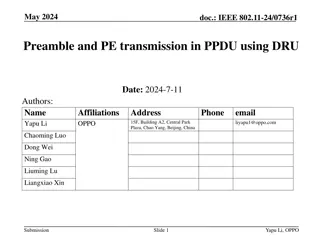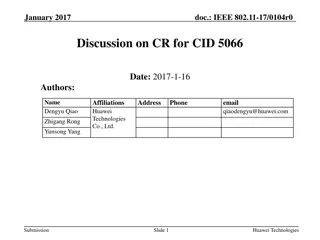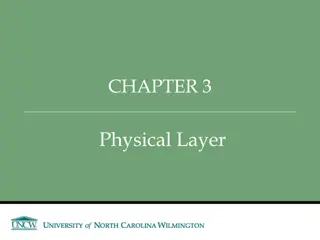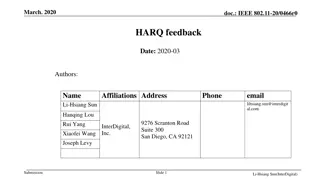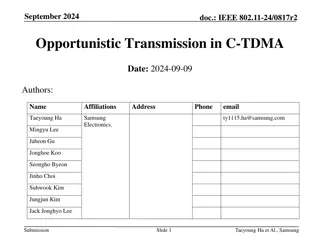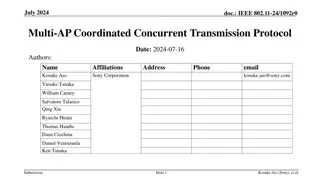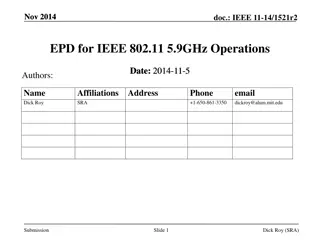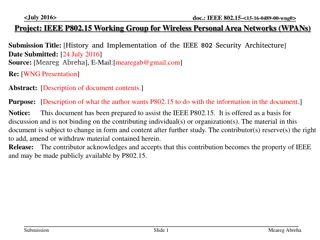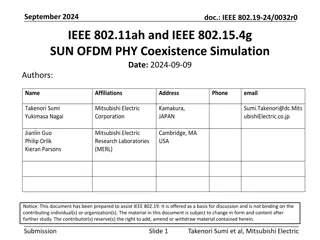IEEE 802.11-24/2147r0 Buffered Data Transmission Discussion
This document discusses enhancing stability in buffered DL data transfers after DS mapping change in IEEE 802.11 networks. It addresses challenges like transmission failures due to bad link quality and proposes solutions for improving transmission stability.
Download Presentation

Please find below an Image/Link to download the presentation.
The content on the website is provided AS IS for your information and personal use only. It may not be sold, licensed, or shared on other websites without obtaining consent from the author.If you encounter any issues during the download, it is possible that the publisher has removed the file from their server.
You are allowed to download the files provided on this website for personal or commercial use, subject to the condition that they are used lawfully. All files are the property of their respective owners.
The content on the website is provided AS IS for your information and personal use only. It may not be sold, licensed, or shared on other websites without obtaining consent from the author.
E N D
Presentation Transcript
Dec. 2024 doc.: IEEE 802.11-24/2147r0 Discussion on buffered data deliver Date: 2024-12-27 Authors: Name Affiliations Address Phone email Hang Yang yanghang1@ruijie.com.cn Ke Zhong zhongke@ruijie.com.cn Ruijie Networks Co., Ltd. Hui Che chehui@ruijie.com.cn Fangchang Guo Submission Slide 1 Hang Yang, Ruijie Networks Co., Ltd
Dec. 2024 doc.: IEEE 802.11-24/2147r0 Background The following text has already been included into TGbn SFD[1]: As part of the seamless roaming procedure, during roaming, after the request/response exchange that initiates notification of the DS mapping change from the current AP MLD to the target AP MLD, The current AP MLD may deliver buffered DL data frames for a TBD period of time. The non-AP MLD may retrieve buffered DL data frames from the current AP MLD The non-AP MLD may send UL data to target AP MLD. It is assumed that the target AP MLD is able to deliver data frames to non-AP MLD after the DS mapping change The current AP MLD may forward DL data to the target AP MLD. When and how to initiate the forwarding of DL data is TBD [Motion #27] Submission Slide 2 Hang Yang, Ruijie Networks Co., Ltd
Dec. 2024 doc.: IEEE 802.11-24/2147r0 Introduction In TGBn SFD[1], the buffered DL data transfer between current AP MLD and non-AP MLD after DS mapping change is supported to avoid data loss. In[2,3,4], the buffered DL data transmission may not always being fully supported. During the transmission, the bad link quality between current AP MLD and non-AP MLD may cause transmission failure, thus weakening the effect of buffered DL data transmission. In this contribution, we would like to discuss some details about enhancing stability when buffered DL data transfers after DS mapping change. Submission Slide 3 Hang Yang, Ruijie Networks Co., Ltd
Dec. 2024 doc.: IEEE 802.11-24/2147r0 Recap : buffered DL data transmission in roaming AP 1 AP 2 STA (Current AP) (Target AP) In [5], current AP MLD and non-AP MLD continue to transfer the buffered DL data after DS mapping change in order to avoid data loss. In single link case, STA can only communicate with current AP until the buffer of current AP is cleared or timeout is reached. In dual link case, STA would leave one link to communicate with current AP until the buffer of current AP is cleared or timeout is reached. Preparation / Link set up Phase Roaming Request Context transfer DS mapping change AP1 Roaming Response As [3,4] point out, the bad quality link may cause a higher transmission failure issue, and even get no much gain from buffered transmission. Considering that the buffered DL data transmission is performed during roaming procedure, the link1 condition between STA and current AP may be less than ideal and may even get worse. Buffered DL data transmission Buffer is cleared or Reach Timeout Link1 disable AP2 DL data from AP2 Submission Slide 4 Hang Yang, Ruijie Networks Co., Ltd
Dec. 2024 doc.: IEEE 802.11-24/2147r0 Discussion on buffered DL data transmission To improve the stability of transmission, during the buffered DL data transmission, STA could measure the link status and provide feedback to current AP. AP 1 (Current AP) STA Roaming Request Context transfer DS mapping change Option 1: Based on STA s measured result, STA may send a leaving request signaling to current AP, requesting to terminate the buffered DL data transmission and switch to target AP immediately. Conditions that STA send leaving request may include: RSSI of Link1 (STA- AP1) is lower than a threshold RSSI of Link2 (STA-AP2) is much higher than Link1 (if STA could measure the Link2) Other TBD conditions may cause transmission failure After receiving Leaving Request from STA, current AP could instruct STA to disconnect the link1. Current AP could forward unsent buffered data to Target AP (if supported). Roaming Response Buffered data transmission E.g., RSSI lower than threshold Submission Slide 5 Hang Yang, Ruijie Networks Co., Ltd
Dec. 2024 doc.: IEEE 802.11-24/2147r0 Discussion on buffered DL data transmission Option 2: STA provides the measured result to current AP, and the AP decide to terminate the buffered DL data transmission or continues to transfer. When link feedback from STA is not suitable for transmission, current AP could instruct STA to disconnect the link1. Conditions that current AP decide to terminate transmission may include: RSSI of Link1 (STA- AP1) is lower than a threshold RSSI of Link2 (STA-AP2) is much higher than Link1 (if Link2 feedback is available) Other TBD conditions may cause transmission failure Current AP could forward unsent buffered data to Target AP (if supported). AP 1 (Current AP) STA Roaming Request Context transfer DS mapping change Roaming Response Buffered data transmission AP decide to terminate transmission To reduce the impact on data transmission, the feedback from STA could be sent as part of header (e.g., in A-Control field). Submission Slide 6 Hang Yang, Ruijie Networks Co., Ltd
Dec. 2024 doc.: IEEE 802.11-24/2147r0 Summary In this contribution, we discussed the details on buffered data transmission during roaming During buffered data transmission, STA could measure the link quality and provide feedback to current AP. This will contribute to current AP terminate the buffered data transmission at the appropriate time and avoid poor links affecting transmission. Option 1: Based on STA s measured result, STA may send a request to current AP, requesting to terminate the buffered DL data transmission and switch to target AP immediately. Option 2: STA provides the measured result to current AP, and AP decide to terminate the buffered DL data transmission or continues to transfer. The feedback from STA may be sent as part of header to reduce the impact on data transmission. Submission Slide 7 Hang Yang, Ruijie Networks Co., Ltd
Dec. 2024 doc.: IEEE 802.11-24/2147r0 References [1] IEEE 802.11-24/0209r7, Specification Framework for TGbn [2] IEEE 802.11-24/0655r0, Thoughts on SMD Roaming and FT Roaming [3] IEEE 802.11-24/1476r0, Seamless roaming follow up [4] IEEE 802.11-24/934r1, Some thought on the data plane of seamless roaming Submission Slide 8 Hang Yang, Ruijie Networks Co., Ltd
